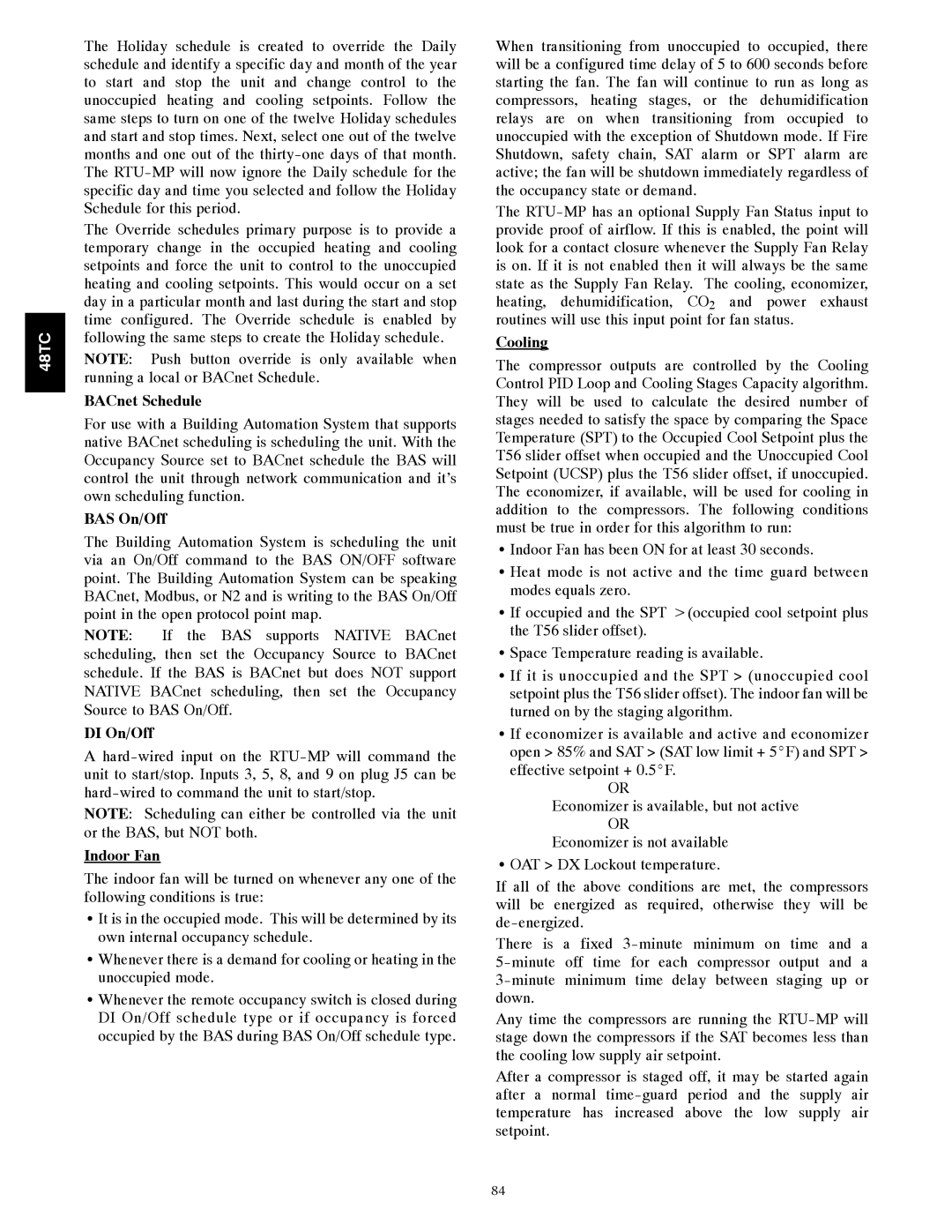48TC
The Holiday schedule is created to override the Daily schedule and identify a specific day and month of the year to start and stop the unit and change control to the unoccupied heating and cooling setpoints. Follow the same steps to turn on one of the twelve Holiday schedules and start and stop times. Next, select one out of the twelve months and one out of the
The Override schedules primary purpose is to provide a temporary change in the occupied heating and cooling setpoints and force the unit to control to the unoccupied heating and cooling setpoints. This would occur on a set day in a particular month and last during the start and stop time configured. The Override schedule is enabled by following the same steps to create the Holiday schedule.
NOTE: Push button override is only available when running a local or BACnet Schedule.
BACnet Schedule
For use with a Building Automation System that supports native BACnet scheduling is scheduling the unit. With the Occupancy Source set to BACnet schedule the BAS will control the unit through network communication and it’s own scheduling function.
BAS On/Off
The Building Automation System is scheduling the unit via an On/Off command to the BAS ON/OFF software point. The Building Automation System can be speaking BACnet, Modbus, or N2 and is writing to the BAS On/Off point in the open protocol point map.
NOTE: If the BAS supports NATIVE BACnet scheduling, then set the Occupancy Source to BACnet schedule. If the BAS is BACnet but does NOT support NATIVE BACnet scheduling, then set the Occupancy Source to BAS On/Off.
DI On/Off
A
NOTE: Scheduling can either be controlled via the unit or the BAS, but NOT both.
Indoor Fan
The indoor fan will be turned on whenever any one of the following conditions is true:
SIt is in the occupied mode. This will be determined by its own internal occupancy schedule.
SWhenever there is a demand for cooling or heating in the unoccupied mode.
S Whenever the remote occupancy switch is closed during DI On/Off schedule type or if occupancy is forced occupied by the BAS during BAS On/Off schedule type.
When transitioning from unoccupied to occupied, there will be a configured time delay of 5 to 600 seconds before starting the fan. The fan will continue to run as long as compressors, heating stages, or the dehumidification relays are on when transitioning from occupied to unoccupied with the exception of Shutdown mode. If Fire Shutdown, safety chain, SAT alarm or SPT alarm are active; the fan will be shutdown immediately regardless of the occupancy state or demand.
The
Cooling
The compressor outputs are controlled by the Cooling Control PID Loop and Cooling Stages Capacity algorithm. They will be used to calculate the desired number of stages needed to satisfy the space by comparing the Space Temperature (SPT) to the Occupied Cool Setpoint plus the T56 slider offset when occupied and the Unoccupied Cool Setpoint (UCSP) plus the T56 slider offset, if unoccupied. The economizer, if available, will be used for cooling in addition to the compressors. The following conditions must be true in order for this algorithm to run:
S Indoor Fan has been ON for at least 30 seconds.
S Heat mode is not active and the time guard between modes equals zero.
S If occupied and the SPT >(occupied cool setpoint plus the T56 slider offset).
S Space Temperature reading is available.
S If it is unoccupied and the SPT > (unoccupied cool setpoint plus the T56 slider offset). The indoor fan will be turned on by the staging algorithm.
S If economizer is available and active and economizer open > 85% and SAT > (SAT low limit + 5_F) and SPT > effective setpoint + 0.5_F.
OR
Economizer is available, but not active
OR Economizer is not available
S OAT > DX Lockout temperature.
If all of the above conditions are met, the compressors will be energized as required, otherwise they will be
There is a fixed
Any time the compressors are running the
After a compressor is staged off, it may be started again after a normal
84
